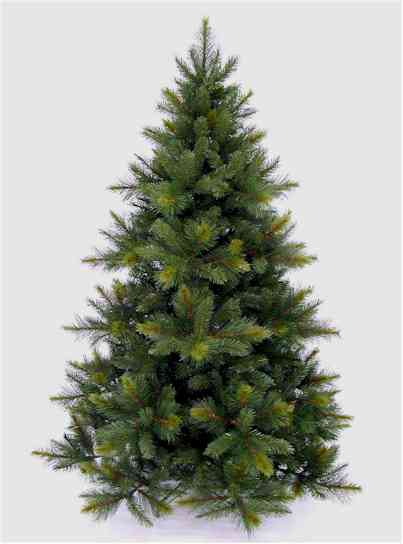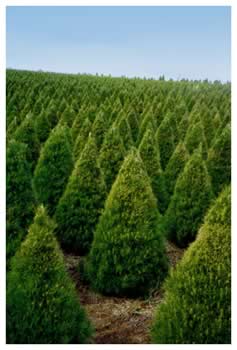Christmas trees are appearing in homes throughout the country and families prepare for the holiday season. But in this age when we are all asked to be aware of the impact we are having on the environment, is the right choice to purchase an artificial tree and use it year after year, or go in search of the perfect living tree to be the centerpiece of our holiday decorating?
The answer may surprise you.
Artificial trees do offer a long-term solution for your Christmas tree decorating needs. And I have to admit, the latest generation of “fake” trees don’t look that fake. They’ve come a long way from the first artificial trees that were actually manufactured by a toilet brush company. That’s right, the first artificial tree was pretty much a really tall, green, toilet brush. But today, until you get close, you’d be hard pressed to distinguish the artificial trees from the real thing… except of course for the missing fresh pine smell.
Economically, artificial trees can also be easier on your wallet. For the cost of a single large live tree, you can purchase an artificial tree that looks the same but will last for several holiday seasons. Sticker shock has become part of the annual trek out to find the family Christmas tree at a local tree lot. If you want your real tree to meet your eye level or above, be prepared to pay in the neighborhood of $100 before you can lash the tree to your roof and drive it home.
So if they look the same, cost less, can be used year after year, and can prevent living trees from being chopped down… should we all be lining up to purchase an artificial tree this year? Well, maybe not.
While chopping down a living tree may see like the most un-environment friendly thing you can do, in this situation it actually appears to be the “greener” choice. Because it’s not so much about how many uses you can get from your tree… as it is about what the tree is made of, and what it does to the environment when it is created and when you dispose of it.

Artificial trees are manufactured using a polyvinyl chloride (or PVC), which is a petroleum-derived plastic. The raw material for fake Christmas trees is both non-renewable and polluting. Furthermore, PVC production results in the unhealthy emission of a number of carcinogens, such as dioxin, ethylene dichloride and vinyl chloride.
Additionally, in order to make the PVC needles on artificial trees more malleable, the manufacturers use lead and other additives that have been linked to liver, kidney, neurological, and reproductive system damage in lab studies on animals. The Children’s Health Environmental Coalition warns fake trees "may shed lead-laced dust, which may cover branches or shower gifts and the floor below the tree."
Some artificial trees actually come with warning labels due to their lead content. And not that we’ve recently had any problems with excess lead content in items imported from China (ahem), but approximately 85% of the artificial trees imported by the United States come from China.
Richard Maas, the director of the Environmental Studies program at the University of North Carolina-Asheville, offers some tips for people who suspect that their artificial tree may contain lead:
- Keep children away from the tree. Do not allow them to touch the tree.
- If you touch the tree, was your hands thoroughly before touching your face or handling food.
- Do not vacuum dust from under the tree, especially with a vacuum that does not have a HEPA filter. Vacuuming could spread lead dust through the air in tiny particles, creating an inhalation danger.
Hmmm. Well then… that puts a bit of a damper on the Christmas cheer.
So what about real Christmas trees? Well, we know what they are made of… an all natural, all renewable source. But there are some components of the Christmas tree industry that aren’t quite as green. Most trees are harvested after 8-12 years, and require maintenance over that period. In addition to watering, some Christmas tree farms use pesticides and chemicals for pest control and to speed growth. Also, when it comes time for delivering those trees to Christmas tree lots, they must be transported by truck to the local communities.

The good news is, while those trees are growing they help to sequester the carbon dioxide that is produced by modern industries. Each year, an acre of Douglas fir trees can absorb 11,308.7 lbs of carbon dioxide. And frequently, Christmas tree farms are placed in areas that would otherwise be unusable. Due to their hardiness, Christmas trees can be planted on barren slopes where few other plants successfully grow, as well as fill in areas under power lines.
When the time comes for harvesting the trees, each tree that is cut down must be replaced. So most tree farms plant 1 to 3 new trees for every one that is cut, in order to to maintain a constant supply. So fortunately the tree population is not reduced due to Christmas tree farming; but instead is maintained, protected, and in many instances increased.
And in terms of the transportation costs and impact, trees must be grown fairly locally in order to make it into homes while still fresh. So some transporting and trucking is part of the supply line… but most likely is a much shorter trip and burns much less fuel than importing artificial trees from China. And there is the added bonus of supporting a local businesses as opposed to buying a foreign import.
But if you buy ten real trees in ten years as opposed to only one artificial tree in the same period, do the benefits of the real trees still outweigh the negatives of the fake ones? Clearly you can save money by purchasing a single artificial tree. But it is important to look at the environmental difference between the two options.
An artificial tree may be used for 5, 10, or 15 years… but eventually it will be disposed of it in favor of something new. Unfortunately artificial trees are not biodegradable and cannot be recycled, so their disposal has a significant impact to the environment. If disposed in a landfill, artificial trees will never breakdown but rather permanently remain in landfills. If disposed of by incineration, the PVC in artificial trees will emit into the atmosphere dioxins and other carcinogens into the air.
On the other hand, when the holidays are over a real tree can be recycled. The branches and trees can be ground into mulch. The mulch provides a protective barrier for the roots of other plants and vegetation while preventing weeds from growing. The mulch then decomposes, providing the nutrients plants need.
In our area, it isn’t even necessary to transport your tree to a recycling center. The Boy Scouts come by each neighborhood during the two weekends following Christmas, and for a small donation will pick up any trees left by the curbside and deliver them to a nearby recycling center. You’ve got to love those Boy Scouts!
There are still proponents for both sides of the Christmas tree debate. But short of forgoing a tree altogether, the real trees are the best option when considered from an environmental perspective. So the best advice? Go to a local tree farm or lot, and have a great time picking out the family Christmas tree. Make a big deal of the event, possibly stopping for hot chocolate or cider somewhere on the way home. Once your tree is home, keep it well watered… and respect the “three strand” limit on joining strings of lights together. (Most Christmas tree fires are the result of overloaded electrical circuits, not dry trees.) And when the holiday season is over, make sure your tree is disposed of properly at a recycling center. This way your family Christmas tree can enjoy a second life... as mulch to help nurture and protect the next generation of trees.





Comments